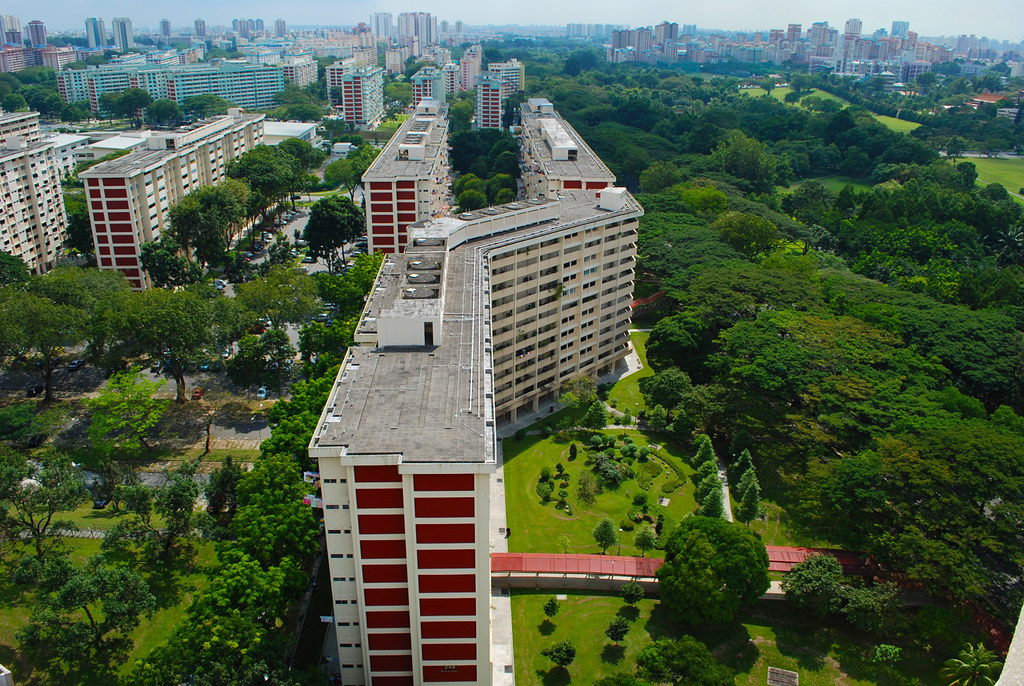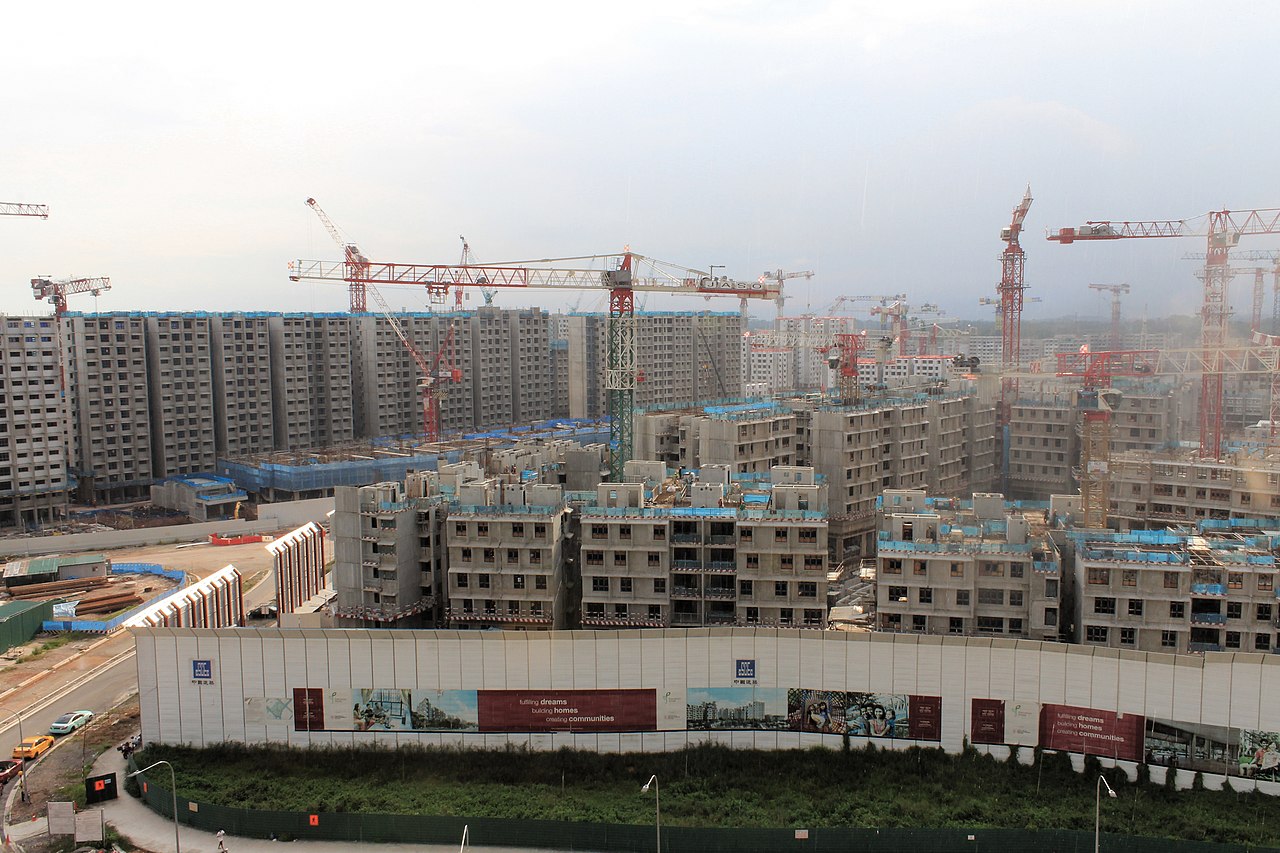How HDB's neighbourhood retail is evolving
In the previous issue, the article “Are Singapore’s new towns less complex?” noted that cites are complex adaptive systems, and asked whether pre-1995 neighbourhoods with old-generation activity centres had greater mass in the form of premises, businesses, and employment than post-1995 areas dominated by new-generation activity centres. Here, Practice Professor Fong Chun Wah ponders the related questions: Why has this come about, and how has the retail scene adapted to the external environment? What can we expect in future?

Practice Professor Fong Chun Wah,
Deputy Director of NUS Cities, is a course leader in the NUS Cities courses Liveable Cities and Cities for All. He was previously Deputy CEO (Building) at HDB.
It was the mid-1890s. A ship arrived from China with eager immigrants looking for a new life in Malaya. Amongst them was a 10-year-old boy named Loke Hoo Yin and his mother, Madam Mak. In her wisdom for her son to learn a trade, he became an apprentice to a cobbler.
The tough discipline and hard work in the early years paid off. In time, Hoo Yin became an established cobbler and owned a shophouse. To run the business at a shophouse in Petaling Street called Kian Hung, he employed around 20 workers, many from China.
The shop prospered and became famous under British rule. The shop made shoes and handbags for Robinsons, sewing on the Robinsons label to make these early branded goods. British officials often also came to the shop directly to order shoes and bags. Hoo Yin’s wife Swee Ngan, an excellent seamstress, sewed and embroidered ladies’ dancing shoes
and bags.
With the Second World War, the fortunes of the shop disappeared. The clientele no longer existed. More importantly, with industrialisation and cheap mass production of shoes and bags, there was no market for bespoke, handcrafted shoes and bags.
This story of my grandfather in Malaya, illustrates how quickly, within a generation, businesses can flourish and disappear, affected by changes in customer base, technology, and external factors such as politics and affordability.
The retail environment will continue to evolve. What changes have we seen in Singapore?
In 1959, Singapore attained internal self-rule. With the enactment of the Planning Ordinance and the Housing and Development Act (H&D Act) in 1960, two new bodies, the Planning Department in the Prime Minister’s Office, and the Housing and Development Board (HDB) were formed to take over from the Singapore Improvement Trust, the public housing agency under the British. HDB was tasked with solving the dire housing problem.
HDB not only built homes but planned and developed towns. Under the H&D Act, HDB was empowered to clear and redevelop slums and urban areas [1]. Its Resettlement Department resettled squatter settlements, villages and farms. By placing both clearance and rehousing options under one authority, two corresponding operations could be planned in unison.
Resettlement meant that not only how we lived changed, but also how we made a living. Resettlement efforts, especially in the 1960s and 70s, help to meet the demand for land for both the public and private sectors [2].
The book Housing a Nation: 25 Years of Public Housing in Singapore (1985) documented the social research carried out on the resettlement of a village called Soon Hock. It included how economic activities in the village were affected. These could be grouped under manufacturing/processing, retailing and production of hawker food. All this changed when these trades moved to industrial estates or HDB shops. From a village-based clientele, retailers had to adapt to new ways of running a business, since some lacked entrepreneurial talent, and had to meet challenges including new costs like rental, competition [3], and establishing a new clientele.
The planning concepts of the first generation of towns planned and developed by HDB established the model for many other HDB towns. These towns had a hierarchy of commercial centres, from precinct shops close to home to neighbourhood centres with its cluster of retail and service shops, markets and hawker centres serving homes within a 400 m service radius, to the town centre where emporia, supermarkets, cinemas and restaurants were located.
Many people running businesses were resettled into retail shops, and often, these were family run. Living quarters were provided for some shops to allow home and retail spaces to be co-located. Such a planning model allowed residents to be well-served while providing a new form of livelihood for resettled persons.
Heartland retail shops (HDB towns have been referred to as the “heartlands”) have become a part of the cultural heritage of Singapore, providing convenience to heartlanders while also playing an important social role in being a catalyst for social mixing and community building [4].
In HDB’s Sample Household Survey 2018, an island-wide survey that is carried out every five years, amongst the top three hangout places for residents were shopping centres and coffee shops [5]. Similarly, street hawkers were resettled into hawker centres and issued hawker licences. Hawker centres have since been recognised by UNESCO as an intangible cultural heritage of humanity.

The rise of new towns
In the 1980s and 90s, HDB developed many new towns, with a massive building programme. Beginning with Yishun, 11 new towns [6], now classified as Middle-Aged Towns, modelled after the first batch of new towns planned by HDB [7], followed the new town structural model consisting of neighbourhoods, each with its own neighbourhood centre.
With the march of progress, education levels rose in Singapore. Between 1985 to 2010, there was rapid growth from industry to modern service, such as in finance, business, info-comm and entertainment. Labour shortages around 2011 to 2015 meant that a productivity-driven growth model had to be adopted. This proved particularly challenging for many traditional domestically-oriented services, including retail and hospitality [8].
Lifestyles also changed, not only where the people lived and where they worked, and the types of work done, but also how they shopped and where they ate. More women began to join the workforce, increasing the number of dual-income families [9]. Coupled with a five- or six-day work-week, meant less time spent in their hometowns. With the rise of air-conditioned shopping centres and supermarkets, in response also to lifestyle changes, shops in neighbourhoods fared poorly in newer towns.
By the 1990s, when Punggol was planned, a new town model was introduced, with smaller, more intimate estates of 2 to 3,000 households served by a cluster of shops, usually at a transport node, such as a Mass Rapid Transit station. There were fewer neighourhood centres planned.
But, even while lifestyles changed, residents still wanted a wet market. A wet market was tried and introduced in the first neighbourhood centre in Punggol, but business was very poor especially on a weekday. Air-conditioned supermarkets with longer operating hours had gained popularity by then.
More private participation comes in
In 1989, the government launched the first sales of land parcels for commercial development in town centres. This allowed for private developers to participate in the provision of commercial facilities in HDB towns. The first four sites launched were one shopping complex and one cineplex each in Yishun and Tampines Town Centres. This was the start of bringing Orchard Road-style shopping and entertainment into the heartlands. For the first time, the cineplex, with multiple cinema halls in one building, was introduced to Singapore.
Over time, other town centres also had their own shopping complexes, with cinemas and other facilities such as a bus interchange integrated with shopping. They were seamlessly linked to MRT stations, making town centres the convenient hubs for facilities.
Today, it is common to find public facilities such as polyclinics, community clubs, police stations, in privately-developed commercial complexes. As part of government land sales requirements, private developers would build such public facilities to be handed over to the appropriate authorities.
In the same spirit of private participation, several neighbourhood centres’ development parcels were also launched for sale. At the same time, HDB-developed neighbourhood centres also morphed to become air-conditioned shopping centres in response to changing tastes in shopping, providing air-conditioned comfort and bringing various facilities under one roof. In the eastern part of Sengkang for example, two neighbourhoods are served by such malls: Rivervale Plaza is developed by HDB and Rivervale Mall by a private developer.
The physical form of shopping centres has changed, and so are the considerations for choice of retail and food mix. Viability and profit for developers, especially private developers, as well as retailers, are critical considerations. Hence, the retail mix to attract footfall is important. Fastfood chains, popular eateries, popular fashion and apparel, and restaurants draw crowds. Retailers are no longer mom-and-pop or family-run; productivity and turnover are key. It is the survival of the fittest.
The retail scene continues to evolve
In more recent years, the retail scene in Singapore, and in fact worldwide, has continued to evolve. Online shopping has gained momentum with increased use of IT, and this has allowed Singaporeans access to a world-wide selection of goods. While catalogue shopping has been common for decades in the USA, shopping from the comfort of home has become increasingly popular in Singapore.
Even pre-Covid-19, there was a growing trend for online purchases, with 60% of households living in public and private housing making such purchases in 2017/18 compared with 31.3% in 2012/13 [10]. The pandemic further accelerated this trend.

This online shopping phenomenon has had an impact on brick-and-mortar shops, with bookshops being one of the earliest to fold. Big department stores were not spared, both internationally as well as in Singapore.
This has also affected retailers. In the 2022 report of the Heartland Shops Study [11] conducted by HDB and Enterprise Singapore, many business-owners reported strong competition from online and e-commerce sites, which offer more competitive prices. This was in addition to other challenges such as an ageing workforce.
More recently, Chinatown retailers found that business has dropped considerably for the weeks leading up to the Lunar New Year in February 2024, and again, one reason given was strong competition from online retailers.
Meeting new needs of the population
How did Singapore respond to such challenges? How would the retail needs of the population to be met when developers may not be prepared to sink in dollars before a sizeable catchment of residents is established? How do we balance provision and viability? What do residents need and want?
In October 2015, HDB announced [12] that it would build four new neighbourhood centres in Punggol, Hougang and Sembawang, resuming the building of such centres in more than a decade, to meet the needs of residents in a more timely manner. In addition, the planning of these centres was based on feedback and focus group discussions with residents, and hence incorporated spaces for interaction and events, as well as other facilities to meet their needs. In one centre, Oasis Terraces, in Punggol, a Polyclinic was included.

Woodlands Civic Centre [13], where many public services were co-located, was first completed in Woodlands Regional Centre in 2000. However, the most celebrated and widely popular integrated development, Kampung Admiralty, was also located in Woodlands but as part of the neighbourhood centre development. It won the Urban Land Institute Global Award for Excellence in 2021. The development integrated senior housing with medical care, a hawker centre and retail, as well as a child care and elderly care facility. Kampung Admiralty paved the way for more integrated development.
New-generation neighbourhood centres respond to changing needs of the community. They also provide space for the community to come together, hence the covered community plaza has become one of the features of such new centres. It provides a space for all kinds of events to take place, from Zumba exercise to community events, festivals and bazaars.
With the new thrust of “Live Well” under HDB’s roadmap Designing for Life launched in 2020, new HDB neighbourhood centres were conceptualised as Social and Wellness Hubs. Apart from their traditional commercial function, these enhanced facilities will offer a wider variety of wellness choices to encourage more community interaction, and the adoption of an active and healthy lifestyle. These include healthy food options, communal spaces for socialisation, and exercise areas.
In addition to such centres, HDB has introduced new ways to activate community spaces. To complement retail shops in precinct clusters, Bidadari Greenway along Bidadari Park Drive, which runs along the length of Bidadari Estate, was planned with retail clusters, as well as social community facilities along its length to help activate this park connector and serve as a community spine.
In Tengah, farmways connect many precincts and are activated with parks and playgrounds, community farms, cycling and walking trails as well as shops and social community facilities such as child care centres and centres for the elderly in the HDB blocks flanking the farmways.

Where is there room for variety?
The future is bright. While there will be chain stores that cater to popular demand, it is heartening to see the emergence of new retail offerings. Young entrepreneurs are setting up bakeries and retail outlets in HDB towns, even in the more mature estates, bringing a new vigour to older estates and a new generation of heartlanders.
“Hawkerpreneur” is a term that has been coined to describe young people setting up hawker stores which often bring a new take on local favourites. Home entrepreneurs set up home offices to supply cakes and baked goods. The Home Office scheme, introduced in June 2003, allows small businesses to be run from both public and private housing, providing an alternative venue for small businesses to operate.
There is an increased interest in traditional crafts, as well as, at the other end of spectrum, tapping into technology, 3D-printed products. Technology will also change how goods will be delivered to shops and homes. Social enterprises that believe in making a positive impact on the world are also growing. We can now find hand-crafted Singapore souvenirs and not just the usual mass-produced Merlion keychains. Demographic changes like a rapidly ageing population will bring about a new market for goods and services.
Satisfaction with estate facilities has increased, according to the HDB Sample Household Survey 2018, with satisfaction with retail shops increasing from 93.4% to 97.9% from 2013 to 2018, 94.7% to 97.4% for markets, and 92.4% to 96.2% for eating establishments. However, there has also been increased dissatisfaction amongst two groups – those living in five-room and bigger flats, and families with young children [14]. The dissatisfaction centred on a limited selection of products or lack of retail provisions near home.
One initiative to overcome the challenges of viability and manpower was the introduction of more vending machines. Vending machines bring more convenience to more remote areas where retailers find it is not viable to set up shop. In August 2016, the first vending machine dispensing hot food was launched in Sengkang.
At the Oasis Terraces, a new-generation neighbourhood centre co-located with a polyclinic in Punggol, HDB introduced two mobile apps, RetailerLink and ShopperLink, to help retailers go digital and enhance the shopping experience for shoppers. Shoppers get the latest news on special deals.
An Entrepreneur Cluster was introduced in Oasis Terraces, where lower fit-out costs and rents allowed online-to-offline businesses and new businesses to try out their ideas and learn to run a retail store. While encouraging innovation and entrepreneurship, the centre also enables residents to find more niche products.
This article focuses on a retail scene which continues to evolve, innovate and respond to challenges and changes in the environment, needs and demands.
But retail is only part of a complex world. Retail plays an important, complementary role with all other facilities including social services, and sports and recreational amenities, to bring about richness and variety in HDB towns and communities. There is room for much food for thought still, on how to plan further to meet future needs, and to allow for even more spontaneous innovation and variety.
References
[1] Housing A Nation, 1985 HDB, p 306
[2] Housing a Nation, p 316. Between 1961 to 1984, some 228,861 squatters in all categories were resettled, providing new homes and livelihood, and allowed for rapid development.
[3] Housing a Nation, p 341
[4] Heartland Shops Study Summary Report, November 2022, Housing & Development Board and Enterprise Singapore. There are about 15,200 heartland shops in Town Centres, Neighbourhood Centres and Precinct Clusters in HDB towns.
[5] HDB Sample Household Survey 2018, Public Housing in Singapore: Residents’ Profile, Housing Satisfaction and Preferences, p 121
[6] Middle-aged towns are Jurong East, Jurong West, Bukit Batok, Choa Chu Kang, Bukit Panjang, Woodlands, Yishun, Bishan, Serangoon, Hougang, Tampines and Pasir Ris.
[7] Toa Payoh, Ang Ko Kio, Bedok and Clementi.
[8] MAS 2015: An economic history of Singapore: 1965-2065
[9] Resident female labour participation rate has steadily increased over the years. Department of Statistics’ report Labour Force in Singapore 2022 shows females made up 47% of the workforce in 2022.
[10] HDB Sample Household Survey 2018 monograph, Public Housing in Singapore: Residents’ Profile, Housing Satisfaction and Preferences, p. 140
[11] Heartland Shops Study Summary Report, Nov 2022.
[12] Straits Times, 3 Oct 2015: HDB unveils next-gen neighbourhood centres in Punggol, Hougang and Sembawang.
[13] Woodlands Civic Centre complemented Causeway Point, a privately developed commercial complex. Besides banks, restaurants and retail as well as childcare centre, it had government agencies like HDB, CPF Board, the Town Council, SingPost and MinLaw Mediation Centre providing services. NLB co-located its regional library with the Civic Centre.
[14] HDB Sample Household Survey 2018, pp 125, 128

